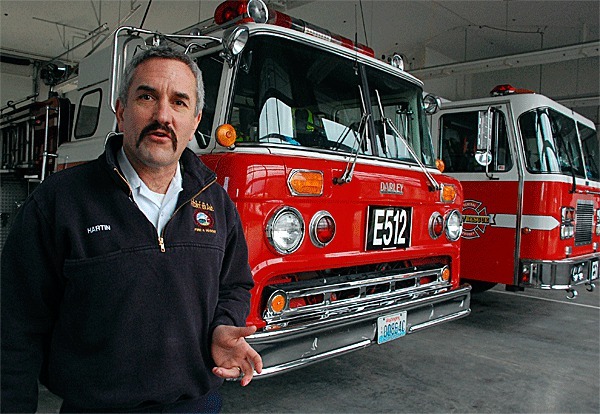Central Whidbey Fire and Rescue is taking a close look at its future, and among the topics under discussion are the expansion of one station, the closing of another, new engines and a levy lid lift.
The fire district’s board of commissioners, along with Chief Ed Hartin and other senior department officials, have just begun a strategic planning effort to examine and identify capital and operational needs over the long term, some that go out as far as 50 years.
This early in the process, little more than a loose framework of ideas has been discussed. Hartin said it will be a least a few more months before he is ready to make any solid recommendations to the board, much less get their endorsement of any set direction.
“There’s a lot of moving parts here,” Hartin said.
However, Hartin has an idea of where the district needs to go. And perhaps the most immediate need is to address two of the fire district’s five engines. Both have reached the end of their service life at 25 years of age and one has been sitting idle since the spring of 2009.
A new fully outfitted engine runs about $500,000 but paying for them really isn’t the issue, Hartin said. Both could be purchased immediately as the fire district has about $1.5 million squirreled away in its capital expenditures fund. What needs to be decided is whether to buy both or just one engine.
“We could likely operate with four and not affect our level of service,” Hartin said. “We have far bigger problems finding people to staff them.”
The fire district operates on a model of both paid firefighters and volunteers, most of which are the latter. But the job isn’t what it once was.
“I got all my training right here,” said Central Whidbey Fire Commissioner Tom Smith, at a special meeting discussing the strategic plan last week. “We can’t do that anymore.”
The training required to be a firefighter, even as a volunteer, has steadily increased to the point where departments commonly struggle with recruitment and retention of their volunteer force. At Central Whidbey, the problem has given birth to other problems, such as staffing small outposts like Station 52 on Morris Road.
The building, constructed in 1986, is manned by four volunteers and is host to a water tender and rescue vehicle. According to Hartin, the structure’s small size and its location within the response zones of stations in Coupeville and on Race Road give it little operational value.
While the drain on financial resources is nil, its four volunteers may be of better use at another station, Hartin said. However, closing it down is something that will have to be carefully considered.
“People get nervous when you close a fire station,” said Fire Commissioner Paul Messner, during the special meeting.
Hartin believes the commissioners will also need to examine an expansion of Station 53 on Race Road. Firefighters currently bunk in a trailer behind the station, which provides limited bed space and reduces response time, Hartin said. One proposal is to build an addition that would house up to six firefighters — enough to accommodate the needs of the station over the next 50 years.
Also under consideration is the construction of a one to two-bay maintenance facility. The fire district currently has to send its rigs off island for some service.
But with only about $1.5 million saved for capital projects, the commissioners made it clear that many of these plans will be out of reach without additional financial support from voters.
“It’s all a wish list,” Messner said.
Although nothing has been ruled out, the commissioners seem united in their wish not to borrow money with options such as a long-term bond. Borrowing means interest, and interest means your project will be more expensive.
According to Hartin, perhaps the best option would be to pursue a levy lid lift so that the commissioners can begin putting away money annually for capital projects. Central Whidbey Fire’s current tax rate is set at 86 cents per $1,000 of assessed value. State law puts the cap for fire districts at $1.50.
But these are tough economic times and with Whidbey General Hospital seeking a $50 million bond this spring, the commissioners told Hartin that anything pitched to the community will have to make sense and be financially responsible.
“There’s a lot of competition for money and no one has any,” Messner said. “We’ll have to have all our ducks in a row.”



